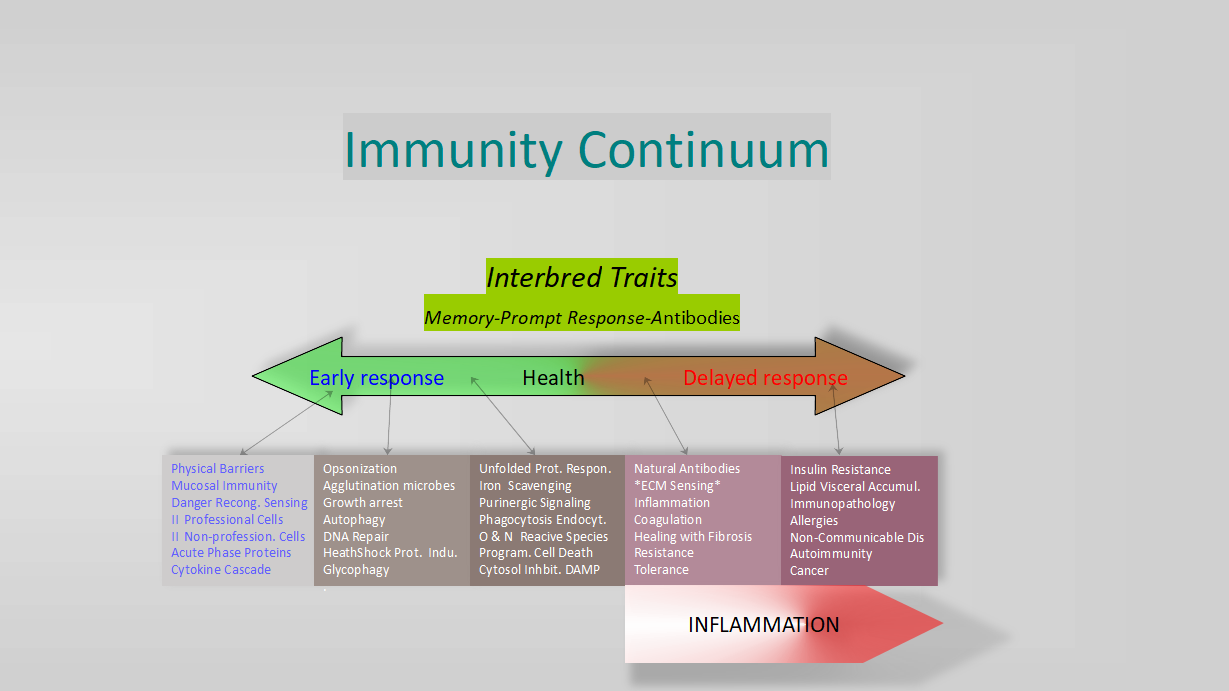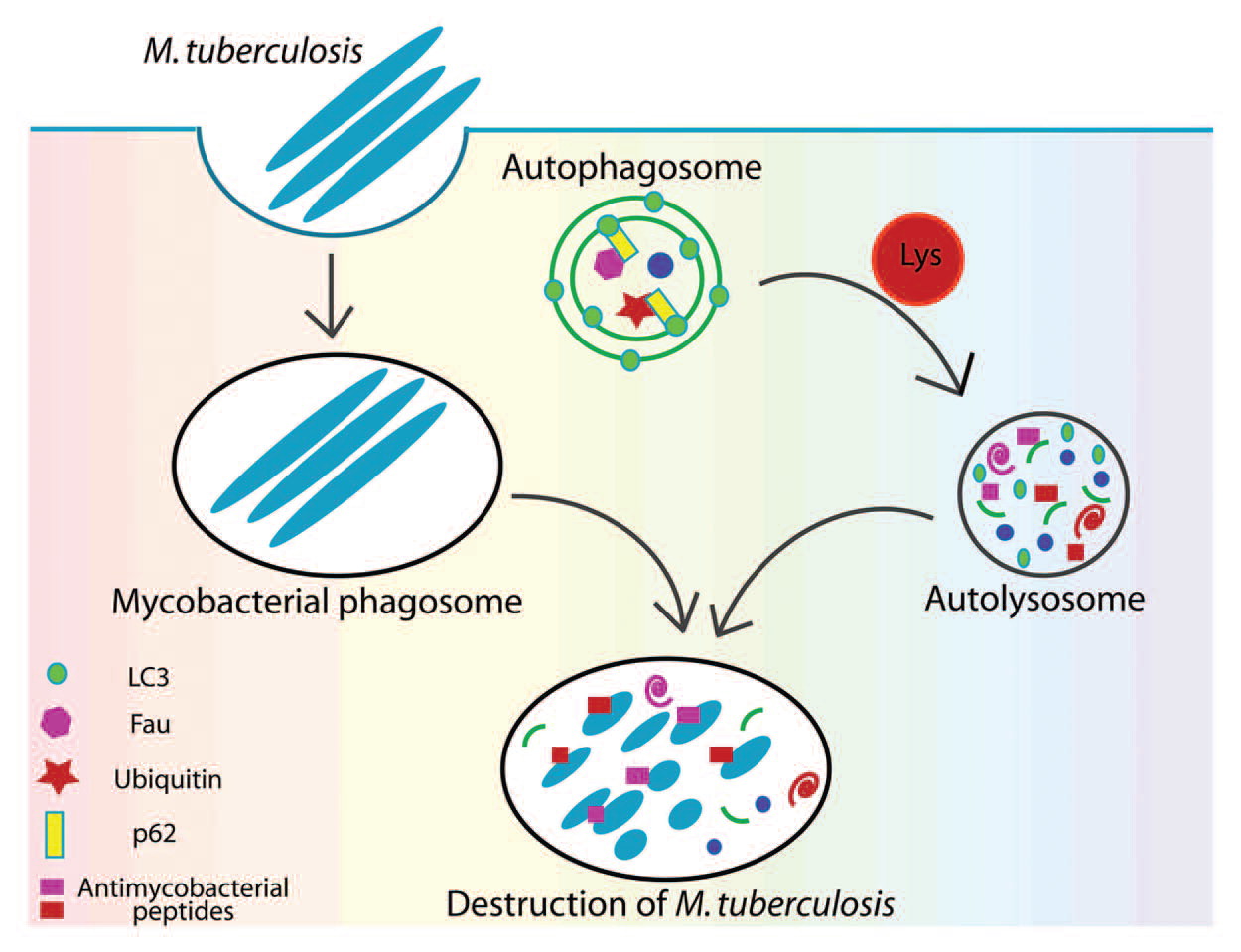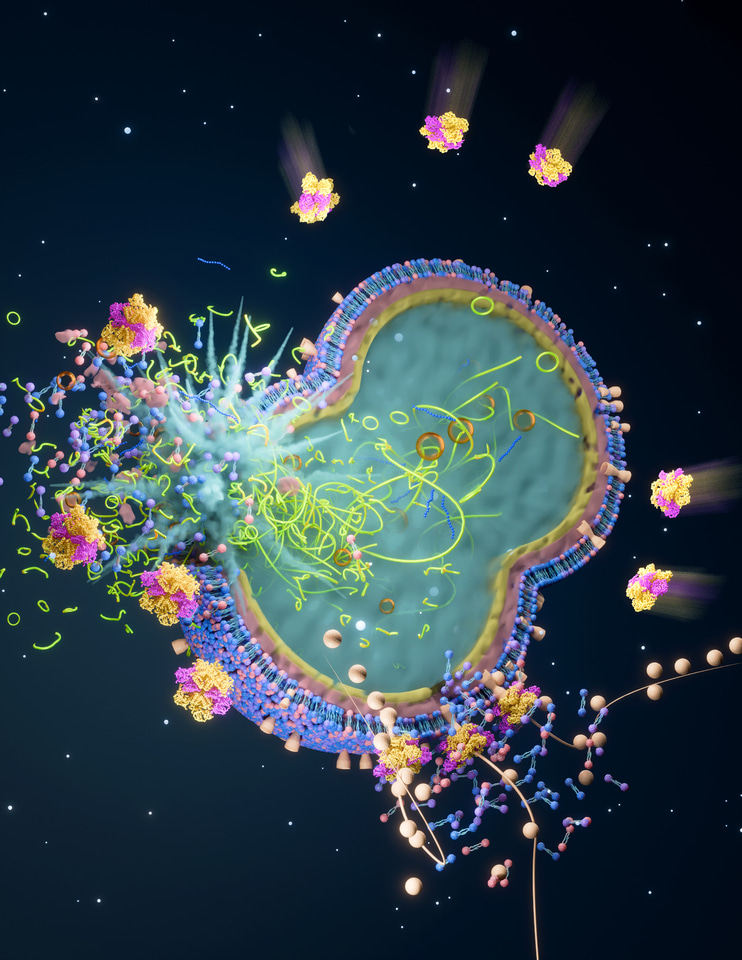How could innate immunity pass unnoticed for so long ?
Published in Biomedical Research

Presenting tissue/microenvironment control as an embodiment of how to intervene in the constitutive cell-autonomous response targeting an optimal interactome for inducement has been daunting. It defies pharmacology as it is presently conceived and requires new multivalent mechanistic restatements with a pristine lexicon necessarily unfamiliar to most.
Discoveries of resistance in innate immunity have been described in separate chapters and have never been explained comprehensively. "The cell's autonomous response window for advanced healing" is a first attempt to collate such knowledge and explain how it functions collectively, well before the response summons the late inflammatory components of resistance (adaptive immunity). Such a view is based on solid basic science and strong clinical evidence, but in some aspects of the constitutive mechanistic construct, it lacks validation in cell and molecular research. With further development, elucidation at such a level will hopefully be consistent with the theorized molecular aspect.
The lines of evidence that strongly motivated writing the article on the innate immunity construct consisted of the ideal regenerative-healing outcome observed in early research and translated to the clinic, and the formidable defense against infection noticed in injured tissues, both quite obvious and unprecedented. The first line of evidence is described in detail in the article. But new evidence on innate immunity antimicrobial defense, which is not included in the article, is referenced and briefly discussed below, adding robust validation to extensive findings of injured tissue combating and remaining free of infection.
For decades, it was believed that the primary function of peptides derived from proteasome degradation was antigen presentation by the major histocompatibility complex class I to launch adaptive T-cell immunity. But research during the last decade has clarified that the function extends to the generation of antimicrobial peptides with cationic properties on an unimaginable scale and variety, through further tryptic proteosomal degradation caused by changes in proteomic composition and function and induced by pathogens to eventually induce the extraction of these cationic fractions, which perforate the pathogen's membrane, causing the arrest of bacterial growth; without adaptive participation, and still within the first line of defense (2) .
In 2011, Ponpuak and Deretic (3) described that in autophagy, phagosomes are more than just a residence vacuole for M. tuberculosis. The adaptor molecule p62, or sequestosome 1, interacts with phagosomal substrates and sequesters harmless cytosolic components (the ribosomal protein rpS30, the precursor FAU, and ubiquitin) for degradation, releasing antimicrobial peptides from used or discarded material. This gives the phagosome lysosomal and maturation characteristics, which, along with the capture of hydrolases and the intermediate mobilization of substrates and their acidification, eventually lead to its fusion into a true autolysosome. The assumption that the outcome of this transformation was to provide simply free amino acids to be recycled during periods of starvation is thus challenged. It has since been elucidated that the proteolysis of these cytosolic proteins ends in a mixture of cryptic peptides with antimicrobial power, constituting the new natural antibiotics called "cryptides," which are generated from discarded biological material. Or by specific chain formations from bacterial surface proteins carrying the ubiquitin tag, which may be plucked from the membrane and fed to the proteasomes, seriously compromising the integrity of the bacterial cell wall and the spillage of pathogen contents in the cytosol(5). In short, the transformation and recycling enhance a valuable post-function, such as eliminating mycobacteria, notorious for their formidable resistance to disposal; see Fig. 1.
Fig. 1
 Elimination of M. tuberculosis via autophagy and p62. Mycobacterium is phagocytosed by macrophages and resides within the phagosome for at least some time. When autophagy is induced, p62, as a bifunctional agent, interacts with autophagic substrates and LC3, sequestering additionally cytosolic substrates. Autophagosome maturation and hydrolase capture induce the degradation of all substrates and their conversion into peptides (cryptides) with antimicrobial activity. Taken from (3)
Elimination of M. tuberculosis via autophagy and p62. Mycobacterium is phagocytosed by macrophages and resides within the phagosome for at least some time. When autophagy is induced, p62, as a bifunctional agent, interacts with autophagic substrates and LC3, sequestering additionally cytosolic substrates. Autophagosome maturation and hydrolase capture induce the degradation of all substrates and their conversion into peptides (cryptides) with antimicrobial activity. Taken from (3)
Fig. 2
 Bacterial plucking, taken from (5)
Bacterial plucking, taken from (5)
In March 2025, Goldberg et al. (2) clarified that the production of cryptides with cationic properties also occurs in proteasomal function, which for decades was thought to be limited to generating the histocompatibility complex I or degrading inhibitory proteins (IκBs) to activate nuclear factor kappa B (NF-κB) or to activate protein precursors with transcriptional regulatory functions, such as Spt23p, Mga2p, and Epe1. However, they also showed that the source of extraction is within substrates extracted from the cytosol, as in autophagy. In addition to being a first-order evolutionary step, antibacterial peptides are found in a wide variety of tissues and cells and exert broad-spectrum activity against bacteria, fungi, viruses, and some parasites. In addition to their cationic action, they modulate the transcriptional and translational activity in the host. These peptides have been termed proteasome-derived peptides (PSEI PDDPs) by Goldberg et al. They are constitutively produced, but their production can also be induced as a response to infection. A proteasome regulatory unit, PSME3, promotes tryptic degradation, increasing peptides with cationic terminals. Computational analyses of this phenomenon show that most proteasome proteins are prone to this degradation, and therefore, the proteasome's potential for PDDP production is quite powerful. An in silico identification using the Pepsickle algorithm (4) of potential cleavage sites to obtain amino acids between 10 and 50 units in length, rated with a minimum efficacy range based on structural comparison to peptides with proven antibacterial activity, identified 270,872 putative peptides with cationic carboxyl terminals. In other words, 92% of the annotated genes contain at least one peptide with a cationic terminal. This illustrates the enormous potential of inducing autonomous cellular immunity to treat tissue injuries, without the risk of infection, and with a strong likelihood of generating a tailored antimicrobial to combat the pathogens involved in each specific case. Another interbred function to be added to the Immunity Continuum, Fig. 1 of the article, shown as a poster in this post, introduces the concept of early and accurate immune specificity through multitudinous offerings. Taken together, new thinking is necessary to improve resistance to infection and immunity, seen as a continuum, to finally overcome it.
The identification of Cubrisoft's (the intervention proposed in the article) mechanism of action within the autonomous cellular immunity and the regular absence of infection in lesions treated with this product are consistent with the research described by Goldberg et al. and Sourav et al.. Resource-sparing is at the heart of early resistance, which profits from cytosolic protein waste and a low energetic expenditure, in contrast to the reckless late adaptive defense response(1). This evidence places Cubrisoft at the forefront of combating infection in injured tissues without toxic or unwanted effects, creating optimal conditions for the regenerative repair described in "The cell's autonomous response window for advanced healing" (1).
References
1. Feoli -Tufi E, Redondo GM, Flores JS, Jara DP. The cell's autonomous response window for advanced healing. Discov Med [Internet]. October 10, 2025 [cited November 9, 2025];2(1):1-42. Available from: https://link.springer.com/article/10.1007/s44337-025-00478-4
2. Goldberg K, Lobov A, Antonello P, Shmueli MD, Yakir I, Weizman T, et al. Cell-autonomous innate immunity by proteasome-derived defense peptides. Nature [Internet]. Mar 2025 [cited 2025 Nov 9];639(8056):1032-41. Available at: https://www.nature.com/articles/s41586-025-08615-w
3. Ponpuak M, Deretic V. Autophagy and p62/sequestosome 1 generate neo-antimicrobial peptides (cryptides) from cytosolic proteins. Autophagy [Internet]. March 1, 2011 [cited November 9, 2025];7(3):336-7. Available from: https://doi.org/10.4161/auto.7.3.14500
4. Weeder BR, Wood MA, Li E, Nellore A, Thompson RF. Pepsickle rapidly and accurately predicts proteasomal cleavage sites for improved neoantigen identification. Bioinformatics [Internet]. Sep 2021;37(21):3723-33. Available at: https://doi.org/10.1093/bioinformatics/btab628
5. Ghosh Sourav, Roy Suvapriya, Baid Navin. Host AAA-ATPase VCP/p97 lyses ubiquitinated intracellular bacteria as an innate antimicrobial defence. Nature Microbiology 2025; 10(5):1099–1114 Available at: https://www.nature.com/articles/s41564-025-01984-y?utm_campaign=related_content&utm_source=HEALTH&utm_medium=communities
Follow the Topic
-
Discover Medicine

This is a fully open access, peer-reviewed journal that supports multidisciplinary research and policy developments across the fields of medical and clinical science.
Related Collections
With Collections, you can get published faster and increase your visibility.
Metabolic Wellness: Addressing the Health Prevention and Management of Obesity and Type 2 Diabetes
Obesity and type 2 diabetes mellitus (T2DM) represent two of the most pressing and interlinked public health challenges of the 21st century. With escalating global prevalence, these conditions are no longer confined to affluent nations, but are rapidly rising in developing countries, driven by sedentary lifestyles, dietary transitions, environmental factors, and genetic predispositions. This Collection aims to provide a comprehensive and multidisciplinary examination of the complex biological, clinical, epidemiological, and socio-environmental mechanisms that underpin the obesity-diabetes nexus.
We invite contributions that critically explore the pathophysiological pathways linking adiposity to insulin resistance, including the roles of chronic low-grade inflammation, adipokine signaling, mitochondrial dysfunction, and gut microbiota. Research addressing genetic and epigenetic factors, pediatric and gestational diabetes, ethnic and gender disparities, and emerging biomarkers are particularly encouraged. Furthermore, we seek discussions on intervention strategies encompassing pharmacological treatments, nutritional modulation, lifestyle interventions, and public health policy frameworks that target obesity and T2DM prevention.
This Collection will serve as an essential reference for endocrinologists, diabetologists, obesity researchers, public health professionals, nutritionists, molecular biologists, and policymakers. By integrating global perspectives and cutting-edge research, it aspires to advance understanding and foster collaborative efforts toward mitigating this dual epidemic. Prospective authors are encouraged to contribute original chapters, clinical insights, or region-specific case studies that align with the Collection’s central theme such as:
1. Gut Microbiota and the Obesity-Diabetes Axis
2. Oxidative Stress and Mitochondrial Dysfunction in Obesity and T2DM
3. Epigenetic Modifications in Obesity and Glucose Metabolism Disorders
4. Artificial Intelligence and Digital Health Tools in Managing Obesity and Diabetes
5. Community-Based Interventions for Reducing Obesity and Diabetes Prevalence
Keywords: Obesity, BMI, Diabetes, Pathophysiology, Metabolic Syndrome, Cardiovascular diseases
Publishing Model: Open Access
Deadline: Mar 31, 2026
New Trends in Clinical Laboratory Medicine
The main purpose of the issue is to explore novelties in clinical biochemistry and laboratory medicine. The issue aims to cover different emerging topic.
One significant trend in clinical laboratory medicine is the use of automation, machine learning and artificial intelligence (AI) to improve laboratory workflows, reduce turnaround times, and enhance the accuracy of laboratory test results. Laboratories are adopting automated systems that can perform sample processing, analysis, and result reporting with minimal human intervention, resulting in faster and more efficient testing processes.
Furthermore, there has been a growing interest in using machine learning algorithms to analyze large amounts of data generated by clinical biochemistry tests. These techniques can also help to identify new biomarkers, develop more accurate diagnostic tools, and improve treatment outcomes.
The development of new biomarkers for disease diagnosis and monitoring can improve disease detection and treatment.
In this context, metabolomics can be applied to biomarker discovery, drug development and personalized medicine.
Another ongoing trend in clinical biochemistry is the increased use of personalized medicine. This approach involves tailoring medical treatment to the individual patient's unique characteristics, such as their genetics and metabolism. Advances in genomic sequencing and other technologies have made it easier to identify specific biomarkers and genetic mutations that can be targeted with personalized therapies. Moreover, new rapid diagnostic techniques are requested to tackle problems such as antibiotic resistance. Overuse or misuse of antibiotics recommended by physicians/self-medication at the time of infection has meant that drug-resistant pathogens have become a major healthcare issue, with millions of reported cases every year. Rapid diagnostics plays a pivotal role in the treatment of bacterial infection. For the timely treatment of patients, a rapid antimicrobial susceptibility test (AST) is urgently needed. Advanced diagnostics would allow clinicians to more quickly determine the most effective treatment, reduce the nonspecific use of broad-spectrum antimicrobials, and facilitate enrollment in new antibiotic treatments. A rise in antibiotic resistance is a certainty, therefore, we must develop technologies that will permit rapid AST (within few hours) and are non-invasive (saliva- or urine-based) or minimally invasive. At the same time, Point-of-Care Testing (POCT) has gained significant importance in healthcare due to its potential to provide rapid and accurate diagnostic results directly at the patient's bedside or in a non-laboratory setting. POCT indeed offer rapid, accessible, and versatile diagnostic capabilities, allowing for enhanced patient management, reduced turnaround time, and improved healthcare outcomes. POCT has the potential to revolutionize the way diagnostic testing is performed and integrated into healthcare systems.
SUMMARY
Clinical Biochemistry and Laboratory Medicine have a central role in achieving a quick and correct diagnosis. This Special Issue plans to give an overview of the most recent advances in the field.
This special issue is aimed at providing innovative contribution on new trends and advances on clinical biochemistry related to different topics.
Potential topics include, but are not limited to:
Automated systems
Biomarkers
Metabolomics, Volatolomics
Machine learning, Artifical Intelligence
Rapid diagnostics
POCT
Keywords: POCT, Biomarkers, Metabolomics, Volatolomics, Machine learning, Artifical Intelligence, Rapid diagnostics, Automated systems
Publishing Model: Open Access
Deadline: Jan 30, 2026





Please sign in or register for FREE
If you are a registered user on Research Communities by Springer Nature, please sign in